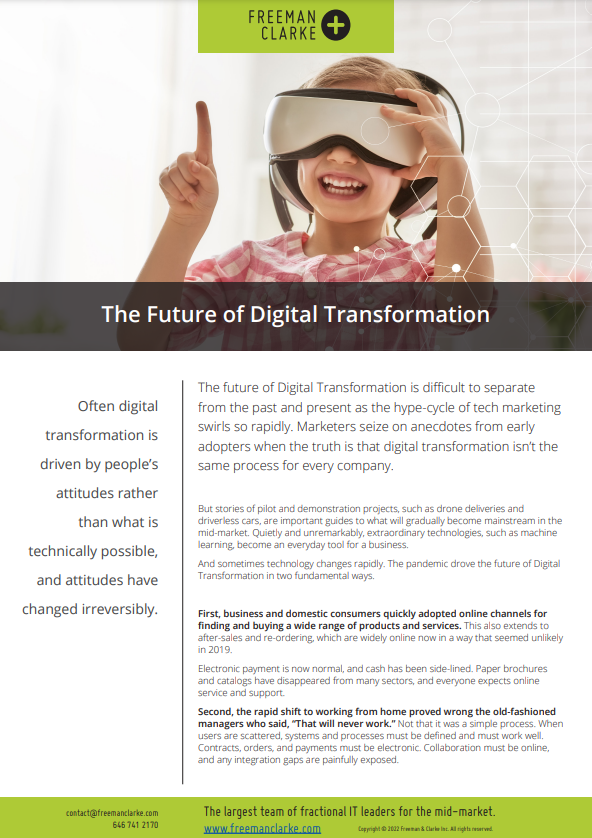The Future of Digital Transformation
The future of Digital Transformation is difficult to separate from the past and present as the hype-cycle of tech marketing swirls so rapidly. Marketers seize on anecdotes from early adopters when the truth is that digital transformation isn’t the same process for every company.
But stories of pilot and demonstration projects, such as drone deliveries and driverless cars, are important guides to what will gradually become mainstream in the mid-market. Quietly and unremarkably, extraordinary technologies, such as machine learning, become an everyday tool for a business.
And sometimes technology changes rapidly. The pandemic drove the future of Digital Transformation in two fundamental ways.

The Future of Digital Transformation
Digital Transformation can drive everyday productivity, but mental health and employee well-being for most people also means human contact.
Download now for FREE!
First, business and domestic consumers quickly adopted online channels for finding and buying a wide range of products and services. This also extends to after-sales and re-ordering, which are widely online now in a way that seemed unlikely in 2019.
Electronic payment is now normal, and cash has been side-lined. Paper brochures and catalogs have disappeared from many sectors, and everyone expects online service and support.
Second, the rapid shift to working from home proved wrong the old-fashioned managers who said, “That will never work.” Not that it was a simple process. When users are scattered, systems and processes must be defined and must work well. Contracts, orders, and payments must be electronic. Collaboration must be online, and any integration gaps are painfully exposed.
Often digital transformation is driven by people’s attitudes rather than what is technically possible, and attitudes have changed irreversibly.
So in the near future, for many mid-market businesses the next phase of Digital Transformation will focus on the following:
- Data has mushroomed, but rather than seeing it as a problem, companies will leverage these new assets for smarter use by humans or AI. Combining data from different sources is now far easier, and cloud-based processing allows for rapid insights that would have been unthinkable even very recently. Data visualization technologies, simple machine learning, and process automation are now a reality and can provide a competitive advantage to companies who take up the challenge.
- Internal integration and adoption of the cloud should be in the rear-view mirror. The next phase will focus on external integration. Businesses should only select tech products that support integration and should gravitate towards suppliers, customers, and partners who form integrated communities. These integrated communities will out-perform those that are not.
Beyond these near-term changes, as cutting-edge tech becomes widely available, companies will have to work harder to distinguish themselves by their actual product or service. Their brand really must mean something, and they really do need a competitive edge. For example, now any company can stream movies like Netflix; Disney+ has stepped in and enjoyed incredible growth on the strength of its content.
In fact, many forms of leisure will increasingly be online (though online leisure becomes more complicated as social media, content, and play converge).
Similarly, products and services will be increasingly virtual, and paid for with virtual currency. Companies will need to tune into this accelerating change and invest in new types of virtual storefronts and virtual branding. Though I hate to use the term, this is the metaverse.
But there is also convergence between digital transformation and ethical and environmental concerns as both regulators and consumers drive this focus. Traceability of products, optimization of materials and energy consumption, privacy, security, and justifiable decision-making will all become part of the digital transformation agenda.
Digital Transformation is not simple, and companies will increasingly be bought for their data and their technology capabilities. Digital Transformation will be a key value driver, and companies often have to secure their future value by buying another’s.
All these transformations will be good for your business if you also successfully meet human needs. Zoom and shared docs are no substitute for real face-to-face collaboration. You cannot have a real creative discussion, shift entrenched opinions, or lift someone’s spirits online. Digital Transformation can drive everyday productivity, but mental health and employee well-being for most people also means human contact.
Most people want their company to have a vision beyond profit; they want to be part of something greater than an integrated process, and they want to draw more from their work than just their salary. Digital Transformation can absolutely make a difference in a mid-market business, but only when you add in the human factor.
Visit our Digital Transformation Knowledge Center which includes all content related to this topic.